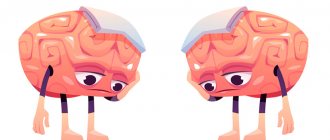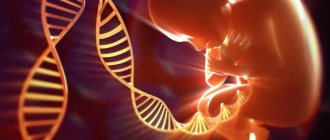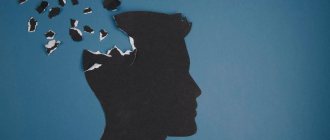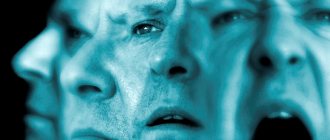Schizophrenia in adolescents is a severe mental illness, the symptoms of which begin to appear at the age of 12-15 years. This age period is characterized by an unstable emotional state, changes in volitional qualities, and increasing impairment of mental abilities. Our clinic provides diagnostics and treatment for boys from 15-16 years old and girls from 15 years old . Timely diagnosis of a mental disorder is difficult, since most of the signs are similar to the manifestation of an adolescent crisis. To make a clear diagnosis, contact the mental health center “Balance” , we will select competent pharmacotherapy with correction of minimal and effective dosages.
Treatment of schizophrenia in adolescents Consult a doctor by phone:
Features of adolescent schizophrenia
The main distinguishing feature of the disease in young people is emotional detachment and isolation . The child does not want to communicate with his classmates and acquaintances and spends time in solitude. Such children have no friends and do not have the usual aspirations for their age. They do not want to become part of the team, establish themselves in it, attract attention to themselves, or stand out in any way.
Both girls and boys are susceptible to developing the disease. Most of them are characterized by sluggish, continuous progression, while the minority are characterized by episodic, paroxysmal progression. Some cases are aggravated by autism and oligophrenia-like defect.
Who is at risk
Adolescents with communication difficulties, prone to hypochondria and loneliness are prone to schizophrenia. This type of personality is called schizoid, or schizotopic, and it often includes gifted, sensitive people (poets, musicians), they usually keep a diary and like to delve into themselves. All this is accompanied by increased reflection, a tendency to reason and the emergence of a special interest that is extremely valuable to him (metaphysical intoxication).
Causes of schizophrenia
The main cause of mental disorder is considered to be a dysfunction of the brain. Several factors contribute to this.
- Genetic predisposition. If both parents in a family suffered from this disease, the probability of the child’s disease will be about 50%. Even if the child’s ancestors suffered from schizophrenia several generations ago, the risk of contracting the disease remains quite high – up to 10%.
- Psychological trauma received in childhood. They relate to the moral oppression and suppression of a child by his parents. A child may become an unwitting witness to scenes of domestic physical or sexual violence. At the same time, he does not have the opportunity to support his loved one, to tell someone about what he saw and heard. The child experiences a strong fear of punishment. Such cases contribute to the splitting of the psyche and the development of undesirable changes in the cerebral cortex.
- Viral infections and other serious diseases suffered by a woman during pregnancy, as well as injuries received during childbirth.
- Consumption of alcoholic beverages and drugs . In adolescence, the danger of this particular risk factor increases significantly. Modern synthetic drugs that young girls and boys try to satisfy their curiosity lead to rapid addiction and the formation of addiction. The negative impact of psychotropic substances leads to severe mental disorder.
Treatment
Children with schizophrenia need adequate treatment from a psychiatrist. The basis of drug treatment for schizophrenia is the use of antipsychotics. These drugs will help eliminate delusions and hallucinations, prevent the development of negative signs, and help the child or adolescent return to normal life.
There are contraindications, you need to consult a specialist!
The task of parents is not only to consult a doctor on time, but also to provide their son or daughter with maximum support, understanding, and love. Although many children become aggressive and disinhibited, this is not their fault, but a consequence of the disease. Therefore, parents should be tolerant of such manifestations of schizophrenia and seek a common language with their children.
Stages of development of schizophrenia in adolescents
There are several stages of development of the disease in adolescent children.
First stage.
The first signs of schizophrenia in adolescents are observed at the age of 12-15 years. They are expressed:
- depression;
- sharpening of character traits;
- the presence of phobias, especially about one’s appearance;
- depersonalization – the child feels a change in the perception of his own “I”;
- difficulty in establishing contacts with others.
Active, manifest stage.
This stage corresponds to the age of 16-20 years . All of the above signs of schizophrenia, characteristic of a 15-year-old teenager, begin to progress rapidly. Now they are expressed more clearly and sharply. It is at this stage that the first visions, hallucinations, delusional and obsessive ideas, and hypochondria appear. At the same time, mental abilities continue to deteriorate - thinking becomes inhibited, speech, memory and concentration disorders are observed.
Stage of recovery, recovery.
This stage corresponds to the age of 20-25 years . Thanks to effective therapy and an individually developed treatment regimen, it is possible to get rid of most productive symptoms in the form of delirium , hallucinations, increased excitability, and also to compensate for cognitive functions. The patient can re-adapt to society, re-enter the university and continue his studies.
Residual, preventive period.
Some patients may retain residual effects of negative symptoms - aloofness and detachment from the outside world, isolation, infantilism. The weak expression of these signs will not be an obstacle to leading a normal, fulfilling life.
What types of diseases occur?
If you look in more detail, there are several types of the disease, each of which has its own characteristics of the course and rate of progression, so, in adolescents, schizophrenia occurs:
- Continuously flowing. It begins in childhood, but after the onset of puberty it acquires a constant course and pronounced signs of mental abnormality.
- Paranoid. Sometimes hallucinatory-delusional. It occurs in the form of changes in mood and the development of delusional ideas.
- Recurrent.
- Acute puberty.
Symptoms and signs of schizophrenia in adolescents
Depending on the form of schizophrenia in children, a predominance of one of the following types of symptoms is observed.
Heboid syndrome.
It is characteristic of the hebephrenic form of schizophrenia. The child develops an increased interest in cruelty and violence . He begins to watch horror films that show scenes of disasters and murders. If there are younger brothers or sisters in the family, they are bullied by the older, sick child. The baby also shows aggression towards animals and other living beings - physically torturing pets, tearing off the legs of frogs. The child addresses his parents rudely, gets offended for no reason, withdraws from the family, and becomes indifferent.
Symptoms and signs of schizophrenia in adolescents with pronounced heboid syndrome also manifest themselves in immoral behavior. The child's actions and behavior are aggressive. He expresses his desire for freedom in vagrancy - he leaves home, spends the night on the street, in basements or attics. Under the influence of negative environmental factors, he begins to use alcohol and drugs. In a state of passion, he commits thefts or more serious offenses.
Parents who notice strange behavior in their child or their manifestation of unreasonable cruelty are strongly recommended to urgently seek help from a psychiatrist. Although heboid syndrome is the most difficult to treat, with timely and adequate treatment, good results can be achieved - a state of remission can be achieved.
Call the “Balance” clinic at +7(499) 495-45-03 at any time. We work around the clock . If necessary, we will arrange for a psychiatrist to visit your home to provide emergency medical care and help with transporting the child to the hospital. We provide all services anonymously . After successful treatment, the child will be able to return to school or university without fear of publicity.
An attack of body dysmorphic disorder.
This is a passion for philosophical ideas, mysticism, spiritualism, the other world, parapsychology and bioenergy. Sick children treat their peers with arrogance and cynicism, considering themselves superior and smarter than them. They prefer loneliness to communicating with friends . Young girls and boys become obsessed with their own appearance, considering themselves ugly and unattractive. Such thoughts greatly reduce their self-esteem - they make them indecisive, unsure of their own abilities.
Mental impairment
Any form of schizophrenia contributes to a gradual deterioration of cognitive function. The child has difficulty perceiving and assimilating new information; it becomes difficult for him to complete homework and concentrate on lessons. As a result, school performance drops sharply. Impairment of mental abilities occurs due to inhibition of thinking, impoverishment of the emotional sphere and weakening of volitional qualities. The child becomes indifferent, apathetic, loses curiosity and interest in learning, and quickly gets tired, especially due to mental overstrain.
Attack of relationship delusions
Such symptoms develop against the background of phobias of ugliness and depression. The child perceives reality inadequately and becomes suspicious. all the actions and deeds of his relatives inadequately , believing that behind his back he is only criticized, condemned and condemned.
If your child's behavior is causing concern and you don't know what to do, consult a specialist . Our clinic employs experienced psychiatrists who will definitely help you. Make an appointment by phone : +7.
Rave
Hallucinations give rise to the next symptom - delusion. It manifests itself in the form of the emergence of various awkward ideas, conclusions, uncoherent speech, and fragments of phrases. There are many types of delirium; the most common types of delirium observed are:
- grandeur, when the patient exalts himself above others;
- influence, in this case the teenager believes that some higher forces are influencing him and his thoughts, reading them;
- persecution, the patient is sure that they are watching him and want to harm him, for example, a neighbor from the eighth floor is a special agent or an alien and must kill him;
- physical disability. Painfully attributes non-existent deformities to himself, for example, a huge nose, one leg shorter than the other, etc.
Diagnosis of adolescent schizophrenia
As noted above, diagnosis of the disease in adolescence is complicated by the similarity of symptoms with an age-related, adolescent crisis or weak expression, blurred signs. An accurate diagnosis can only be made by a psychiatrist, after conducting a series of studies and monitoring the patient for 2-6 months.
In their work, our specialists use all available tools.
- Clinical and anamnestic method. The psychiatrist talks with the patient himself and his parents. Through conversation, he collects information about the severity of symptoms, the time of appearance of the first signs, the stage of the disease, and the form of schizophrenia. This method takes some time. The doctor must observe the development of the disease over time in order to accurately determine the complex of symptoms characteristic of a mental disorder.
- Psychological tests - drawing pictures, Luscher tests, Rorschach tests and others. They play a supporting role and allow the doctor to collect additional, important personal information.
- Neurotest. This is a laboratory method that involves drawing blood. It is used to determine reactions occurring in the nervous system. Neurotest allows you to identify schizophrenia in the early stages of development, when symptoms are still invisible or smoothed out.
- Neurophysiological test system. She studies the child's reactions when exposed to various stimuli on the senses.
- CT, MRI of the brain , if necessary.
- Pathopsychological examination - testing the child’s cognitive abilities.
Only on the basis of a comprehensive examination does our doctor establish a diagnosis, classify the form of schizophrenia and select an individual treatment regimen.
Do you have any questions? Call: +7 (499) 495-45-03 and our specialists will definitely answer them.
Hallucinatory syndrome
The manifestation of pathology can be varied: hallucinations can be auditory, visual, gustatory, olfactory, tactile. The most common variant is auditory, visual is somewhat less common, and other varieties appear in rare cases.
Auditory hallucinations involve the perception of non-existent voices or other sounds. Typical options include the sound of dripping water and the creaking of a door. The sounds are intrusive and irritate the patient. The voices heard by the patient may be talking to each other, or it may be one voice communicating with the patient.
Does treatment help?
Treatment methods for schizophrenia are constantly being improved. They combine medication and psychotherapy, which allows the teenager to understand why he was unable to build an inner space for himself. She also helps him find support - this could be literary creativity, drawing, photography, caring for animals, music... “It is very important to see the special gift of each patient,” emphasizes Virginie Meggle. - Yes, indeed, no one knows how to cure schizophrenia, but it can be managed. Try to understand your child."
Schizophrenics are able to learn to be aware of their illness, even if they cannot completely control it. And about 25% of those diagnosed with schizophrenia eventually stabilize. Sergei Medvedev adds that “modern means of rehabilitation and psychotherapy make it possible to achieve such a remission (weakening of symptoms) that, having seen a schizophrenic during this period, a psychiatrist unfamiliar with his history would not have given him such a diagnosis.”
Related posts:
- How to deal with depression Depression is a disorder of a person’s emotional state, the signs of which are...
- Psychosis: acute, manic, paranoid Psychosis is a complex mental disorder that may have an underlying…
- Constant fear and anxiety in men All people tend to worry about situations that are out of their control...
- Cortisol in children: what does a high level mean? The adrenal glands produce the hormone cortisol and adrenaline, which is often associated with...










